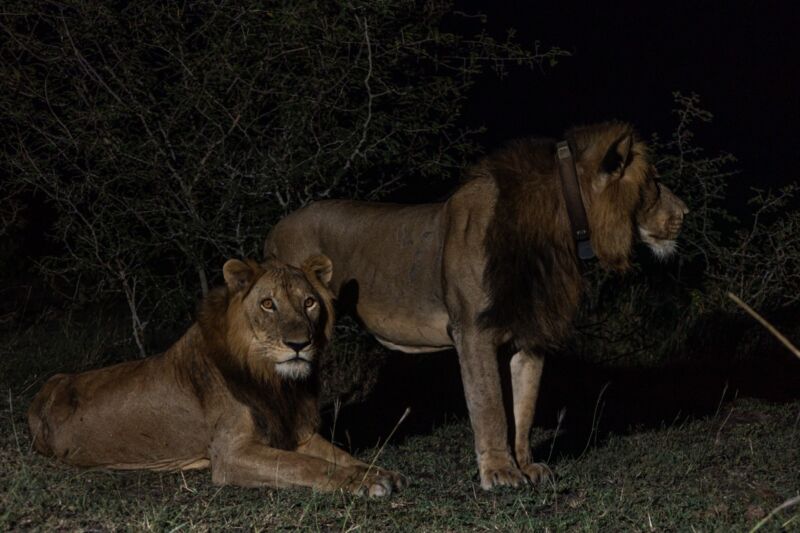
Alexander Braczkowski
On February 4, scientists monitoring lion populations in Uganda captured nighttime thermal drone footage of two lions—brothers dubbed Jacob and Tibu by the Uganda Wildlife Authority—swimming across the predator-infested Kazinga Channel connecting two lakes, most likely to find mates. While there have been prior reports of lions swimming short distances, Jacob and Tibu covered about 1.5 kilometers (nearly one mile)—the longest swim yet recorded, according to a new paper published in the journal Ecology and Evolution.
“The fact that [Jacob] and his brother Tibu have managed to survive as long as they have in a national park that has experienced significant human pressures and high poaching rates is a feat in itself—our science has shown this population has nearly halved in just five years,” said co-author Alexander Braczkowski of Griffith University, who has been working with the government of Uganda since 2017 to monitor the lion population in the area. “His swim, across a channel filled with high densities of hippos and crocodiles, is a record-breaker and is a truly amazing show of resilience in the face of such risk.”
Jacob and Tibu’s impressive feat is likely the result of increased pressure from human encroachment, according to Braczkowski. He co-authored a 2020 paper proposing a novel census technique that could be used more broadly as an early warning of lion declines. Their method revealed a worrying movement parameter for both male and female lions in Uganda’s Queen Elizabeth National Park, where the home range increased to 3.27 km (a 400 percent increase) for males and 2.22 km (a 100 percent increase) for females—likely a response to systematic prey depletion due to poaching, for example. And the sex ratio was dangerously skewed: one male to 0.75 females, a highly unusual occurrence.
“In African lions, males already pay a high cost for large, impressive, sexual signals and take tremendous risks to find mates, establish tenure, and defend lionesses and their cubs,” Braczkowski et al. wrote in their new paper. “This is likely compounded when there is limited access to females or significant human pressure.” Hence, the record-breaking swim.
Lion brothers Jacob and Tibu braved hippos and crocodiles to make the crossing. Credit: Alexander Braczkowski
Braczkowski et al. think it’s likely that Jacob and Tibu were looking for lionesses available to mate. Apparently they had lost a fight for female affection with other male lions just prior to their record-breaking swim and decided it was worth the risk to find mates on the other side of the channel. There is actually a small bridge connecting the two sides of the channel, but there is a constant human presence (two armed guards) on the bridge, which likely deterred the lions from using it.
Going the distance
This isn’t the first time Jacob has defied the odds. The lion is something of a local icon, famous for surviving many prior incidents that might have been the death of a less hardy fellow, one of which cost him a leg. Yes, he made that incredible swim on three legs. “Jacob has had the most incredible journey and really is a cat with nine lives,” said Braczkowski. “I’d bet all my belongings that we are looking at Africa’s most resilient lion. He has been gored by a buffalo, his family was poisoned for lion body part trade, he was caught in a poacher’s snare, and finally lost his leg in another attempted poaching incident where he was caught in a steel trap.”
Evidence for the ability of lions to swim significant distances has been scant to date, but the authors observed such behavior among lions on six other occasions over the course of this last year in western Uganda. They also undertook an extensive online search for other examples. One peer-reviewed paper suggested lions might be crossing the Kwa-Kasaii and Congo rivers but did not provide hard evidence. The authors did find one report of an adult male crossing the 100-meter-wide Zambezi from northern Zimbabwe to Zambia back in 2012, as well as several YouTube videos of male African lions making short swims in swaps of the Okavango Delta.
While African lions have been known to occasionally hunt crocodiles and hippos on the shore, they are much more vulnerable in the water. However, “Records like this indicate that where motivation is sufficient, lions can cross large rivers, which are commonly perceived as barriers to connectivity between extant lion populations,” the authors wrote, despite the high risk of injury or death.
Ecology and Evolution, 2024. DOI: 10.1002/ece3.11597 (About DOIs).

